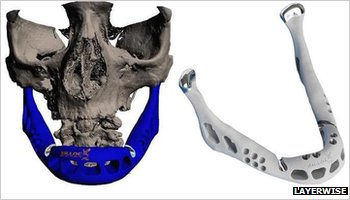Doctors Use 3D Printed Jawbone in Transplant

A CAD image of the jaw bone next to the finished product. Courtesy of LayerWise.
Latest News
February 8, 2012
While not quite on the level of The Six Million Dollar Man, this particular rebuilding of the human body is still pretty cool. Last June, doctors at Hasselt University’s Biomedical Research Institute in Belgium, along with assistance from their fellows the Netherlands, were able to successfully implant a 3D printed titanium jawbone into an 83-year-old woman.
A victim of osteomyelitis (chronic bone infection), doctors believed traditional methods might be to invasive for the advanced age of their patient, so they went the high-tech route instead. The jawbone was manufactured by LayerWise, a Belgian company, to specs provided by the doctors. The complex design is articulated and includes features such as passages for veins which are designed to help incorporate the prosthetic into the patient’s body.
You can build parts that you can’t create using any other technique. For example you can print porous titanium structures, which allow bone in-growth and allow a better fixation of the implant, giving it a longer lifetime.— Ruben Wauthle, LayerWise medical applications engineer
Doctors say the surgery was a complete success, with the patient being able to speak a few words directly after waking from anesthetics, and was able to talk and eat normally the day following the surgery. Post-op work is scheduled to place a fabricated dental bridge onto the jawbone, which will allow doctors to screw a set of false teeth into place.
The jawbone was created using selective laser melting, and was sprayed with a bioceramic coating after the build was complete. At 107g, the artificial jaw is a bit heavier than the one the patient was born with, but doctors say they are confident their patient won’t have any difficulty adapting to the difference.
As time goes by and techniques and technology both become more sophisticated, 3D printing is apt to be used more often by doctors. Dr. Anthony Atala has already demonstrated how it might be possible to build a kidney using an inkjet printer, and Washington State University researchers have been experimenting with a mix of silicon, zinc and calcium phosphate to create bone scaffolding.
Below you can watch a video of the jaw bone being produced.
Source: BBC News
Subscribe to our FREE magazine, FREE email newsletters or both!
Latest News
About the Author
John NewmanJohn Newman is a Digital Engineering contributor who focuses on 3D printing. Contact him via [email protected] and read his posts on Rapid Ready Technology.
Follow DE






